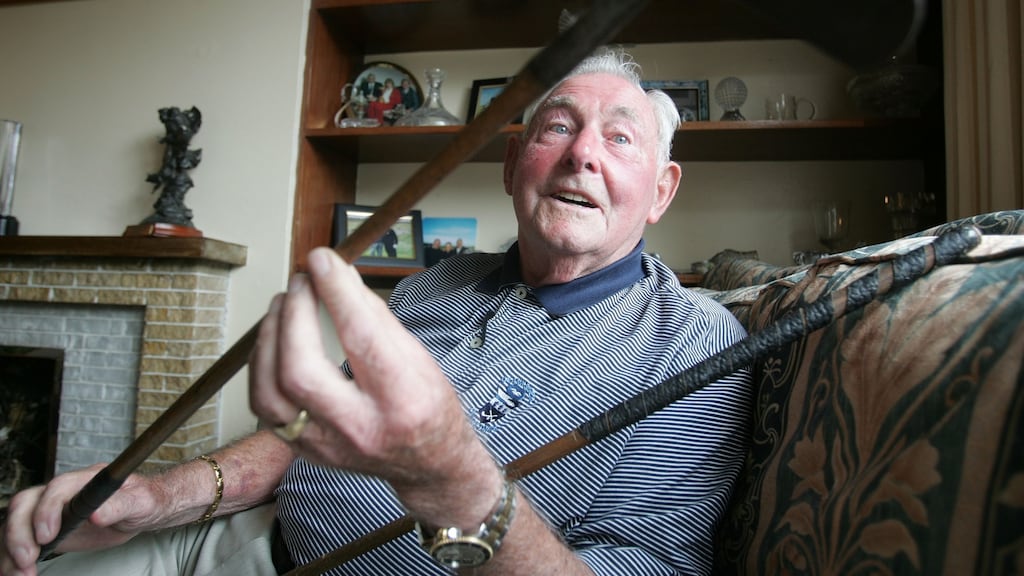Christy O’Connor snr, who has died aged 91, could be considered Ireland’s first superstar in professional golf, a trailblazer who inspired subsequent generations, both by deed and the supportive manner in which he encouraged other young Irish players, including his nephew, the late Christy O’Connor jnr, looking to follow a similar sporting path.
One of 11 children of Michael and Margaret, the family cottage at Knocknacarra, outside Salthill, was within chipping distance of the first green at Galway Golf Club. A childhood fascination inspired a lifelong devotion to the game.
Despite the initial misgivings of his father and of Masters Reidy, O’Sullivan and Moroney at his national school, O’Connor progressed from caddy to assistant professional, part-time green-keeper to professional, incorporating liaisons with Galway GC, Tuam GC, Ashford Castle Hotel GC, Bundoran GC, Killarney and finally Royal Dublin, with which he is synonymous. He was also the touring pro at Royal Dublin from April 1959 until 1975.
Affectionately known as "Himself" to the golfing fraternity in Ireland, he ensured a profile for his country globally, winning 23 tournaments on the British and Irish circuit, a forerunner of the modern European Tour and twice winning the Harry Vardon trophy in 1961 and 1962, as the leading player on the PGA Order of Merit.
Highly regarded
O’Connor was well known and highly regarded by the leading US players of the 1950s, 1960s and 1970s including
Jack Nicklaus
,
Lee Trevino
,
Arnold Palmer
,
Sam Snead
and
Billy Casper
, with the last-mentioned sending a telegram to a surprise celebration dinner for 300 guests on the occasion of O’Connor’s record-breaking 10th consecutive Ryder Cup appearance in 1973 at Muirfield.
It read: “It’s a good thing you weren’t born in the States; otherwise nobody would have ever heard of me or those other two plumbers, Palmer and Nicklaus.” O’Connor viewed the cost of travelling to the US prohibitive for part of his career so turned down numerous invitations to play in the Masters.
He did manage to duel with the Americans in the aforementioned Ryder Cup, playing 36 matches on 10 occasions over 20 years, a record eclipsed only by Nick Faldo. He played an important part in famous victory at Lindrick in 1957, the first time the Americans had been beaten since 1933.
O’Connor clinched the winning point with a seven and six victory in what proved to be a bad-tempered 36-hole singles match against Dow Finsterwald, after which the American refused to shake his hand; even though it was the latter that indulged in the sharp practice.
O’Connor picked up a one-inch putt on the ninth green, assuming it would be conceded. Thinking he had retained the honour at the next tee, he was stopped in his tracks when Finsterwald shouted: “Hold it, you did not finish out. I’m claiming the hole and it’s my honour.” It would be their last verbal communication.
Two years later the Irishman was involved in a terrifying incident where a plane carrying the British Ryder Cup team, as it was known then, from Los Angeles to Palm Springs dropped 4,000 feet without warning in the middle of an electric storm.
As a result of the incident, the group founded the Jolly Lucky Long Drop Club and at 5.30pm on October 29th every year, the survivors raise a glass and toast their escape.
O'Connor won the Canada (World) Cup in Mexico (1958) for Ireland alongside his friend Harry Bradshaw and would go on to make 15 appearances in the event. Other notable milestones included claiming the first £1,000 cheque in British and Irish golf for his maiden victory in the Swallow-Penfold tournament and winning the John Player Classic in 1970, for which he received £25,000.
Biggest regret
O’Connor enjoyed 10 top 10 finishes in the Open, included finishing in a tie for second place in 1965. A failure to win that title was the self-confessed biggest regret of his career. In 2009 he was inducted into the World Golf Hall of Fame, a fitting reward for a superb career. O’Connor drew lavish praise for a beautiful swing but a pet peeve was when he was described as a “natural golfer”.
He countered: “The swing that might indeed have looked natural was forged into the graceful, rhythmic and beautiful one it was said to be, only after the blood, sweat and toil of trial, error and hard work. Then it looked natural.”
Part of his regimen included hitting thousands of balls on the beach at Bundoran and latterly Dollymount Strand in Dublin in atrocious weather conditions, while also dropping balls in atrociously difficult lies; his feats of escapology were legion but honed from a voracious appetite to practise.
It is little wonder that one of the players he admired most was Seve Ballesteros, a respect that was mutual.
It seems apposite to leave the final words to one of Ireland’s greatest sportsmen. “I had a talent and I used it.” What he didn’t add was the pleasure that it gave so many.
He is survived by his wife, Mary, and children Marguerite, Therese, Joan, Peter and Christopher. A daughter, Anne-Marie, predeceased him.










